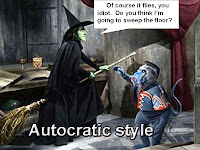Personality: the complex of characteristics that distinguishes an individual or a nation or a group, etc…. (Merriam Webster’s New Collegiate Dictionary, Ninth Edition)
Strictly speaking, the word personality applies only to persons or groups of persons. When we speak of brand personality, however, we refer to “a complex of characteristics that distinguishes” your brand from other brands. Brand personality speaks of brands in the same way that personality speaks of persons.
When you create a brand personality, what you’re really doing is trying to cause your target consumers to think that your brand closely fits his or her personality. By identifying your brand with the way your target consumer sees himself, he is supposed to have a more favorable attitude toward your product.
In a way, your target consumer says of your product, “It fits who I am!”
How do you create brand personality?
Note the boldfaced word fit on this page. You’ll often see that word in this course. From product creation to marketing and advertising, everything you do has to neatly fit together.
So, how do you create brand personality? You do it by a process called transference. First, you identify how your target consumer feels about something or someone. Then you transfer that feeling to your product; that is, cause him to have the same feeling about your product.
For example, Nike focuses on people’s admiration of certain sports heroes. Their advertising then creates an emotional link between the sports heroes and the Nike products.
How do the marketers do this?
They do it by using the most basic technique of advertising: They encourage target consumers to feel—not to think.
If they were to think, would they really be thinking, “Oh, that Tiger Woods is really cool.” If I wear a Nike hat, I’d be cool, too.” No, of course not.
If they were to think, would they really be thinking, “Oh, that Tiger Woods is really cool, and I’m worthless. I need to wear a hat like his so that I can have feelings of self worth."? Again, no. The illogic of it would be obvious.
Those thoughts not what any reasonable person would think, but advertising encourages people to feel that way.
The dark side of advertising:
Probably the most cynical area of advertising and marketing is the promotion of status products. In this area, advertisers try to make the target consumer feel unworthy. Their “remedy” for feelings of unworthiness is to buy their product. As such, they “create a bogus disease and a bogus cure in the same laboratory.”
If they didn’t engage in this practice, people would realize, to give a few examples, that Nike shoes are just shoes; Prell shampoo is just shampoo; and a Gucci handbag is just a handbag. None of these products will make you a more worthy person.
If you’re marketing a product designed to fit a human need, however, you have a simpler job of it. If you need it, all you have to do is tell the target consumer about it. Then the product will sell itself.
The downside of status marketing
There are higher profits in marketing status items, but the market for status items is more volatile (unstable) than the market for necessary items. You should consider that when you market your product.
Let’s separate products and services into four types:
1. Necessary items that are privately consumed
2. Necessary items that are publicly consumed
3. Luxury (status) items that are publicly consumed
4. Luxury (status) items that are privately consumed.
Let’s look at some examples of each.
1. Necessary items that are privately consumed. (Food, drinks such as milk, dish-washing liquid, bath towels, household furniture, etc.)
2. Necessary items that are publicly consumed. (Practical clothing, transportation,
3. Luxury (status) items that are publicly consumed. (Status brand clothing, Starbucks coffee, etc.)
4. Luxury items that are privately consumed. (Bath oil, brand name pajamas, home decorations, etc.)
During economic downturns, luxury (status) items suffer the fastest decreases in earnings. This is especially true of luxury items that are privately consumed.
When scandals attached themselves to companies, luxury items that are publicly consumed suffer the fastest decreases in earnings.
Brand personality made simple
What comes to mind when you hear the following brand names:
 1. Jansport?
1. Jansport? Trendy, styles for the great outdoors. Environmentally responsible.
 2. Nike?
2. Nike? Being like your favorite sports heroes.
3. Adidas? Top quality sportswear most preferred by Olympic athletes.
4. Wrangler? Durable and dependable work wear.
5. Levi Strauss? Comfortable fit, practical for all occasions, socially responsible.
Brand personality made to fit consumers
Look at these same images and you’ll see examples of each brand’s target consumers:

1.
Jansport: Likes to think of himself as trendy, outdoorsy, and environmentally aware. Probably doesn’t litter.

2.
Nike: Hopes to gain some of a sports hero’s popularity by wearing clothes associated with him. Probably has a hard time getting a date.

3.
Adidas: Likes to think that wearing Adidas clothes will make people think he’s athletic. Interest in sports is probably limited to watching television.

4.
Wrangler: Worker who wants his clothes to last. Probably likes country music.

5.
Levi Strauss: Practical. Low key. Prefers comfort over phony images. Probably isn't interested in Paris Hilton or Lady Gaga.
So, you see, brand imaging—the art of creating an image for your brand that will become your brand’s personality—is all about creating an image or personality for your brand that FITS your target consumer’s image of his own personality.
Now you understand brand personality. What about packaging?
In packaging, just as it is with everything else in marketing, FIT is the key. The way you package your product should closely match (fit) the kind of product you’re packaging, the brand personality of the product, the target consumer, the advertising campaign you’ll be using later, and everything else that touches upon the marketing of your product.
Suppose your product is a drug for elderly people. Would it make a lot of sense to package it in such a way that people with frail fingers would have trouble getting it out of the package?
On the other hand, what if your product were a children’s cereal? Wouldn’t it make sense to package it in such a way that small children couldn’t open it while the box is still on a supermarket shelf?
What about the images on the package? Suppose you were marketing an energy drink. Who is your target consumer, and for what purpose are they drinking it?
If your target consumer is a young, athletic type, he probably wants to drink it for more energy before or after exercise. If your target customer is a body builder, he has another purpose. A taxi driver or a worker on the graveyard shift at a factory would have yet another purpose for drinking it. An elderly person would have still another purpose.
Of course, the taste and ingredients in the drink would vary, depending on the purpose your target consumer would have for drinking your energy drink.
The images and color scheme on the package would also differ. Most taxi drivers would not see the connection between his energy needs and the image of a track star on a can of energy drink.
Now it’s your turn!
What about the product you and your team are marketing?
What brand personality will you give your product? Remember to fit it to your target consumer. How will you give your product that brand personality?
What features (size, shape, design, etc.) will your package have to fit your target consumer and the intended purpose of your product?
What colors will you use to fit your package to your target consumer?
What images will you use to fit your package to your target consumer and the purpose of the product?
What if your marketing strategy determines that your product doesn’t come in a package? How will you display and market it?

















































